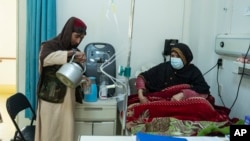Since the Taliban’s seizure of power in Afghanistan in 2021, the nation’s public health sector has been on life support, with foreign aid agencies stepping in to pay health workers and sustain hospitals and local health centers.
The country's donor-dependent economy has teetered on the brink of collapse as foreign donors cut off development assistance and imposed sanctions on governing Taliban entities.
The International Committee of the Red Cross, or ICRC, paid supplemental salaries for more than 10,000 doctors, nurses and staff at 33 hospitals serving 26 million people across Afghanistan.
It also “paid for drugs and other medical supplies, as well as running costs of the hospitals, like electricity, ambulance services, lab tests and food for patients,” Diogo Alcantara, an ICRC spokesperson, told VOA.
The ICRC program ended in August, but the donor-funded payments have continued.
Now, the United Nations children’s agency, UNICEF, has picked up the tab, paying the salaries of more than 27,000 Afghan health workers, including 10,000 women.
The salary payment program serves as a “lifeline in retaining the health workforce and preventing further brain drain” in Afghanistan, according to Kate Pond, a UNICEF spokesperson.
“Lack of access to health care services is of great concern to UNICEF, which is why we have taken concrete steps to keep the health system afloat, ensuring primary and secondary health services are available for women, children and families across Afghanistan,” Pond told VOA in written comments.
Taliban health ministry officials refused to comment to VOA regarding the allocation of limited domestic resources for the health sector. The Islamist regime does not publicly disclose its budget and national spending.
Despite funding from UNICEF, a pressing need for immediate donor assistance has been reported for at least 36 hospitals previously financed by the ICRC to sustain critical services.
While donors have responded to the U.N.'s calls for humanitarian assistance for Afghanistan, only 40% of the required $412 million for critical health services in 2023 has been committed.
Dwindling number of female health workers
For decades, Afghanistan has grappled with a significant shortage of female health professionals, resulting in some of the worst women’s health indicators in the world.
The nation's maternal mortality rate stood at more than 1,600 per 100,000 live births until 2002 but decreased to 620 in 2020, largely due to sustained international technical and financial assistance.
Aid workers say the Taliban’s restrictions on women’s education and work are reversing the progress achieved in Afghanistan’s health sector, especially for women.
“Afghanistan has not produced a single female doctor for more than a year, and this is the worst thing that could happen to our health sector,” said a Kabul Medical University lecturer who did not want to be named in this article.
The Taliban have prohibited secondary and higher education, including medical studies, for girls, giving no indication as to when the gender-based restrictions might be lifted.
“There is a shortage of qualified health workers in Afghanistan in general, and women especially,” said UNICEF’s Pond, adding that some Afghans travel long distances for health care services.
“As a result, more than one-third of the population lack access to health facilities,” she said.
Even before the Taliban’s return to power in 2021, there was no female doctor in some rural districts of Afghanistan.
“If the ban on women’s education and work is not lifted, there will be no female doctor left in Afghanistan in the near future,” said the lecturer.











